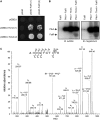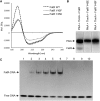Interaction of bacterial fatty-acid-displaced regulators with DNA is interrupted by tyrosine phosphorylation in the helix-turn-helix domain
- PMID: 23939619
- PMCID: PMC3814354
- DOI: 10.1093/nar/gkt709
Interaction of bacterial fatty-acid-displaced regulators with DNA is interrupted by tyrosine phosphorylation in the helix-turn-helix domain
Abstract
Bacteria possess transcription regulators (of the TetR family) specifically dedicated to repressing genes for cytochrome P450, involved in oxidation of polyunsaturated fatty acids. Interaction of these repressors with operator sequences is disrupted in the presence of fatty acids, and they are therefore known as fatty-acid-displaced regulators. Here, we describe a novel mechanism of inactivating the interaction of these proteins with DNA, illustrated by the example of Bacillus subtilis regulator FatR. FatR was found to interact in a two-hybrid assay with TkmA, an activator of the protein-tyrosine kinase PtkA. We show that FatR is phosphorylated specifically at the residue tyrosine 45 in its helix-turn-helix domain by the kinase PtkA. Structural modelling reveals that the hydroxyl group of tyrosine 45 interacts with DNA, and we show that this phosphorylation reduces FatR DNA binding capacity. Point mutants mimicking phosphorylation of FatR in vivo lead to a strong derepression of the fatR operon, indicating that this regulatory mechanism works independently of derepression by polyunsaturated fatty acids. Tyrosine 45 is a highly conserved residue, and PtkA from B. subtilis can phosphorylate FatR homologues from other bacteria. This indicates that phosphorylation of tyrosine 45 may be a general mechanism of switching off bacterial fatty-acid-displaced regulators.
Figures




References
-
- Grangeasse C, Cozzone AJ, Deutscher J, Mijakovic I. Tyrosine phosphorylation: an emerging regulatory device of bacterial physiology. Trends Biochem. Sci. 2007;32:86–94. - PubMed
Publication types
MeSH terms
Substances
LinkOut - more resources
Full Text Sources
Other Literature Sources
Molecular Biology Databases

